Report: Team Performance, Leadership, Conflict, and Vision Strategies
VerifiedAdded on 2021/01/02
|13
|4248
|347
Report
AI Summary
This report delves into various aspects of team dynamics and leadership, focusing on the features of effective team performance, stages of team development, and barriers to success. It explores the comparison of different models used to link individual roles with team performance, such as Belbin's and Tuckman's models. The report further examines effective group norms, beneficial versus destructive conflicts, and methods for conflict resolution. It also evaluates approaches to promoting a shared vision and encouraging the sharing of skills and knowledge within teams. Additionally, the report discusses the meaning, benefits, and strategies for managing risks associated with a 'no blame culture,' as well as a comparison of different leadership and management styles. The report concludes with reflections on adjustments to personal leadership and management styles, providing a comprehensive overview of team-related concepts.

Portfolio of Evidence
Paraphrase This Document
Need a fresh take? Get an instant paraphrase of this document with our AI Paraphraser

Table of Contents
INTRODUCTION...........................................................................................................................1
TASK 1............................................................................................................................................1
P1.1 Features of effective team performance..............................................................................1
P1.2 Comparison of models used to link individual role and development with team
performance.................................................................................................................................1
TASK 2............................................................................................................................................2
P2.1 Stages of team development...............................................................................................2
P2.2 Barriers to success...............................................................................................................3
P2.3 Effective group norms for team development....................................................................3
P2.4 Differentiation between beneficial conflicts and destructive conflicts ..............................4
P2.5 Methods to deal with conflicts in a team ...........................................................................4
P2.6 Comparison between methods of developing and establishing trust and accountability
within a team...............................................................................................................................5
TASK 3 ...........................................................................................................................................5
3.1 Evaluate the ways of promoting a shared vision of a team...................................................5
3.2 Review of approaches that encourages sharing of skills and knowledge between team
members......................................................................................................................................6
TASK 4............................................................................................................................................6
4.1 Meaning of No Blame Culture..............................................................................................6
4.2 Benefits of 'No Blame Culture'.............................................................................................7
4.3 System and Processes can be used to support a no blame culture........................................7
4.4: Strategies for managing risks associated with no blame culture.........................................7
TASK 5............................................................................................................................................8
5.1: Compare different styles of leadership and management....................................................8
5.2: Reflection on adjustments to own leadership and management style..................................9
CONCLUSION................................................................................................................................9
REFERENCES................................................................................................................................1
INTRODUCTION...........................................................................................................................1
TASK 1............................................................................................................................................1
P1.1 Features of effective team performance..............................................................................1
P1.2 Comparison of models used to link individual role and development with team
performance.................................................................................................................................1
TASK 2............................................................................................................................................2
P2.1 Stages of team development...............................................................................................2
P2.2 Barriers to success...............................................................................................................3
P2.3 Effective group norms for team development....................................................................3
P2.4 Differentiation between beneficial conflicts and destructive conflicts ..............................4
P2.5 Methods to deal with conflicts in a team ...........................................................................4
P2.6 Comparison between methods of developing and establishing trust and accountability
within a team...............................................................................................................................5
TASK 3 ...........................................................................................................................................5
3.1 Evaluate the ways of promoting a shared vision of a team...................................................5
3.2 Review of approaches that encourages sharing of skills and knowledge between team
members......................................................................................................................................6
TASK 4............................................................................................................................................6
4.1 Meaning of No Blame Culture..............................................................................................6
4.2 Benefits of 'No Blame Culture'.............................................................................................7
4.3 System and Processes can be used to support a no blame culture........................................7
4.4: Strategies for managing risks associated with no blame culture.........................................7
TASK 5............................................................................................................................................8
5.1: Compare different styles of leadership and management....................................................8
5.2: Reflection on adjustments to own leadership and management style..................................9
CONCLUSION................................................................................................................................9
REFERENCES................................................................................................................................1
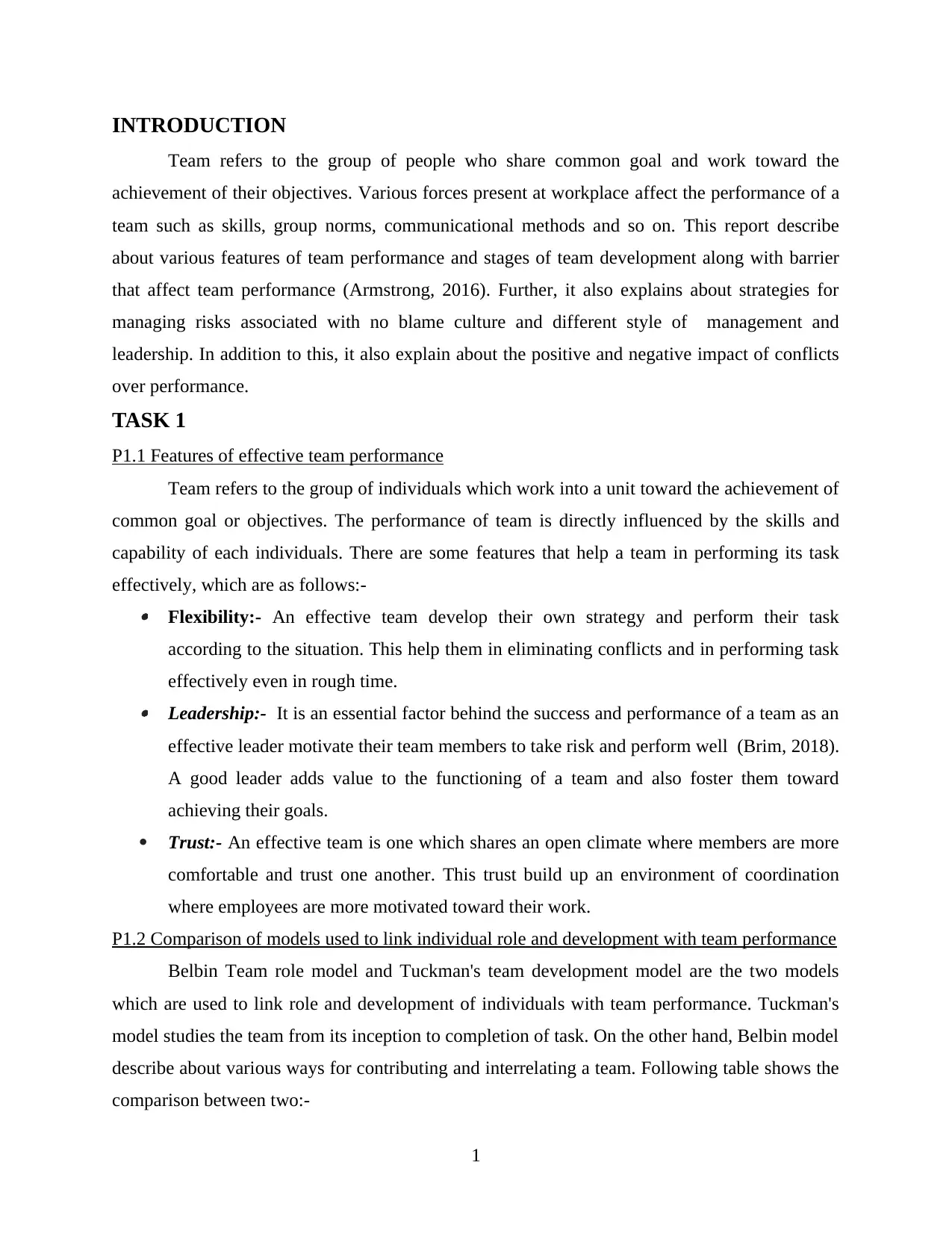
INTRODUCTION
Team refers to the group of people who share common goal and work toward the
achievement of their objectives. Various forces present at workplace affect the performance of a
team such as skills, group norms, communicational methods and so on. This report describe
about various features of team performance and stages of team development along with barrier
that affect team performance (Armstrong, 2016). Further, it also explains about strategies for
managing risks associated with no blame culture and different style of management and
leadership. In addition to this, it also explain about the positive and negative impact of conflicts
over performance.
TASK 1
P1.1 Features of effective team performance
Team refers to the group of individuals which work into a unit toward the achievement of
common goal or objectives. The performance of team is directly influenced by the skills and
capability of each individuals. There are some features that help a team in performing its task
effectively, which are as follows:- Flexibility:- An effective team develop their own strategy and perform their task
according to the situation. This help them in eliminating conflicts and in performing task
effectively even in rough time. Leadership:- It is an essential factor behind the success and performance of a team as an
effective leader motivate their team members to take risk and perform well (Brim, 2018).
A good leader adds value to the functioning of a team and also foster them toward
achieving their goals.
Trust:- An effective team is one which shares an open climate where members are more
comfortable and trust one another. This trust build up an environment of coordination
where employees are more motivated toward their work.
P1.2 Comparison of models used to link individual role and development with team performance
Belbin Team role model and Tuckman's team development model are the two models
which are used to link role and development of individuals with team performance. Tuckman's
model studies the team from its inception to completion of task. On the other hand, Belbin model
describe about various ways for contributing and interrelating a team. Following table shows the
comparison between two:-
1
Team refers to the group of people who share common goal and work toward the
achievement of their objectives. Various forces present at workplace affect the performance of a
team such as skills, group norms, communicational methods and so on. This report describe
about various features of team performance and stages of team development along with barrier
that affect team performance (Armstrong, 2016). Further, it also explains about strategies for
managing risks associated with no blame culture and different style of management and
leadership. In addition to this, it also explain about the positive and negative impact of conflicts
over performance.
TASK 1
P1.1 Features of effective team performance
Team refers to the group of individuals which work into a unit toward the achievement of
common goal or objectives. The performance of team is directly influenced by the skills and
capability of each individuals. There are some features that help a team in performing its task
effectively, which are as follows:- Flexibility:- An effective team develop their own strategy and perform their task
according to the situation. This help them in eliminating conflicts and in performing task
effectively even in rough time. Leadership:- It is an essential factor behind the success and performance of a team as an
effective leader motivate their team members to take risk and perform well (Brim, 2018).
A good leader adds value to the functioning of a team and also foster them toward
achieving their goals.
Trust:- An effective team is one which shares an open climate where members are more
comfortable and trust one another. This trust build up an environment of coordination
where employees are more motivated toward their work.
P1.2 Comparison of models used to link individual role and development with team performance
Belbin Team role model and Tuckman's team development model are the two models
which are used to link role and development of individuals with team performance. Tuckman's
model studies the team from its inception to completion of task. On the other hand, Belbin model
describe about various ways for contributing and interrelating a team. Following table shows the
comparison between two:-
1
⊘ This is a preview!⊘
Do you want full access?
Subscribe today to unlock all pages.

Trusted by 1+ million students worldwide
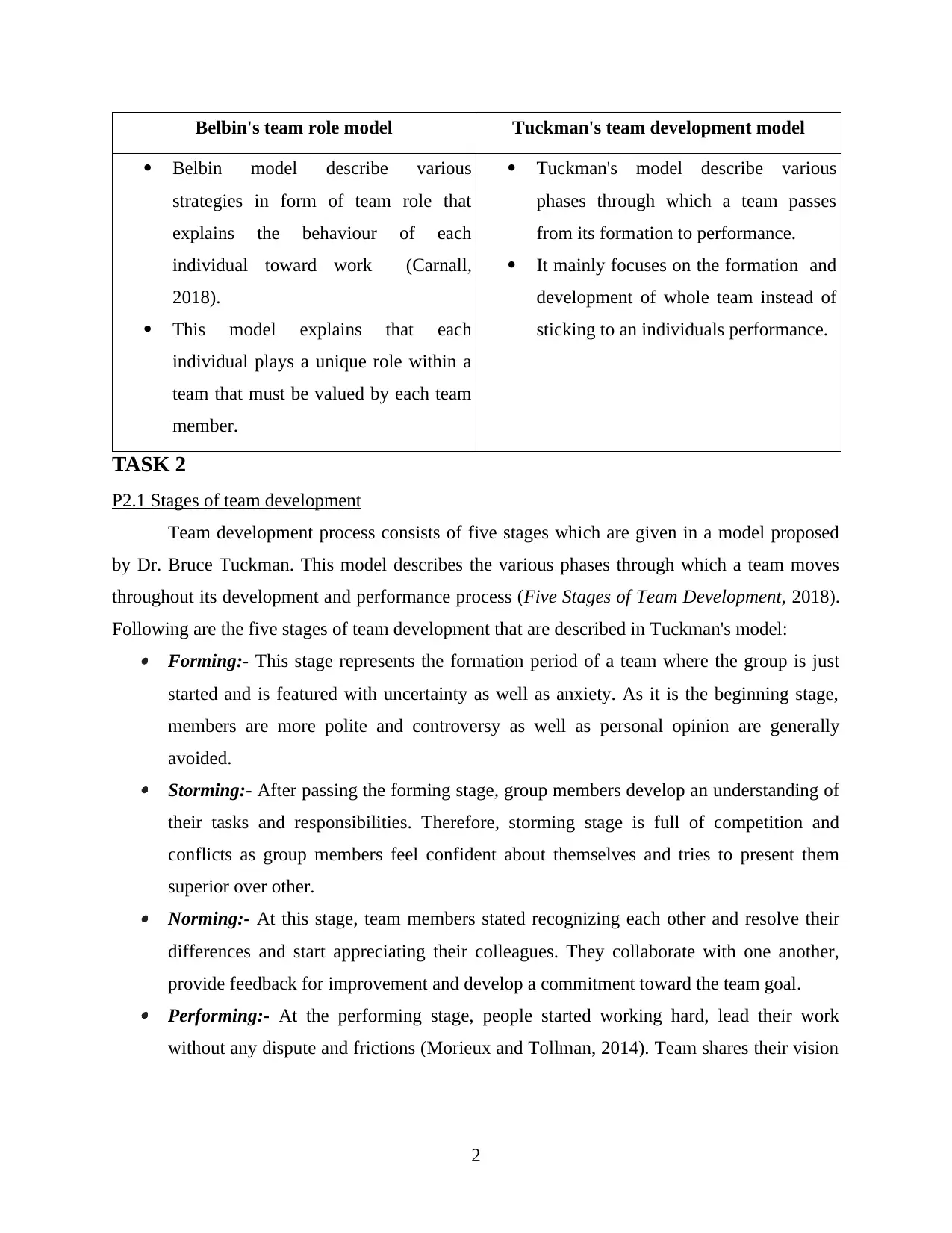
Belbin's team role model Tuckman's team development model
Belbin model describe various
strategies in form of team role that
explains the behaviour of each
individual toward work (Carnall,
2018).
This model explains that each
individual plays a unique role within a
team that must be valued by each team
member.
Tuckman's model describe various
phases through which a team passes
from its formation to performance.
It mainly focuses on the formation and
development of whole team instead of
sticking to an individuals performance.
TASK 2
P2.1 Stages of team development
Team development process consists of five stages which are given in a model proposed
by Dr. Bruce Tuckman. This model describes the various phases through which a team moves
throughout its development and performance process (Five Stages of Team Development, 2018).
Following are the five stages of team development that are described in Tuckman's model: Forming:- This stage represents the formation period of a team where the group is just
started and is featured with uncertainty as well as anxiety. As it is the beginning stage,
members are more polite and controversy as well as personal opinion are generally
avoided. Storming:- After passing the forming stage, group members develop an understanding of
their tasks and responsibilities. Therefore, storming stage is full of competition and
conflicts as group members feel confident about themselves and tries to present them
superior over other. Norming:- At this stage, team members stated recognizing each other and resolve their
differences and start appreciating their colleagues. They collaborate with one another,
provide feedback for improvement and develop a commitment toward the team goal. Performing:- At the performing stage, people started working hard, lead their work
without any dispute and frictions (Morieux and Tollman, 2014). Team shares their vision
2
Belbin model describe various
strategies in form of team role that
explains the behaviour of each
individual toward work (Carnall,
2018).
This model explains that each
individual plays a unique role within a
team that must be valued by each team
member.
Tuckman's model describe various
phases through which a team passes
from its formation to performance.
It mainly focuses on the formation and
development of whole team instead of
sticking to an individuals performance.
TASK 2
P2.1 Stages of team development
Team development process consists of five stages which are given in a model proposed
by Dr. Bruce Tuckman. This model describes the various phases through which a team moves
throughout its development and performance process (Five Stages of Team Development, 2018).
Following are the five stages of team development that are described in Tuckman's model: Forming:- This stage represents the formation period of a team where the group is just
started and is featured with uncertainty as well as anxiety. As it is the beginning stage,
members are more polite and controversy as well as personal opinion are generally
avoided. Storming:- After passing the forming stage, group members develop an understanding of
their tasks and responsibilities. Therefore, storming stage is full of competition and
conflicts as group members feel confident about themselves and tries to present them
superior over other. Norming:- At this stage, team members stated recognizing each other and resolve their
differences and start appreciating their colleagues. They collaborate with one another,
provide feedback for improvement and develop a commitment toward the team goal. Performing:- At the performing stage, people started working hard, lead their work
without any dispute and frictions (Morieux and Tollman, 2014). Team shares their vision
2
Paraphrase This Document
Need a fresh take? Get an instant paraphrase of this document with our AI Paraphraser
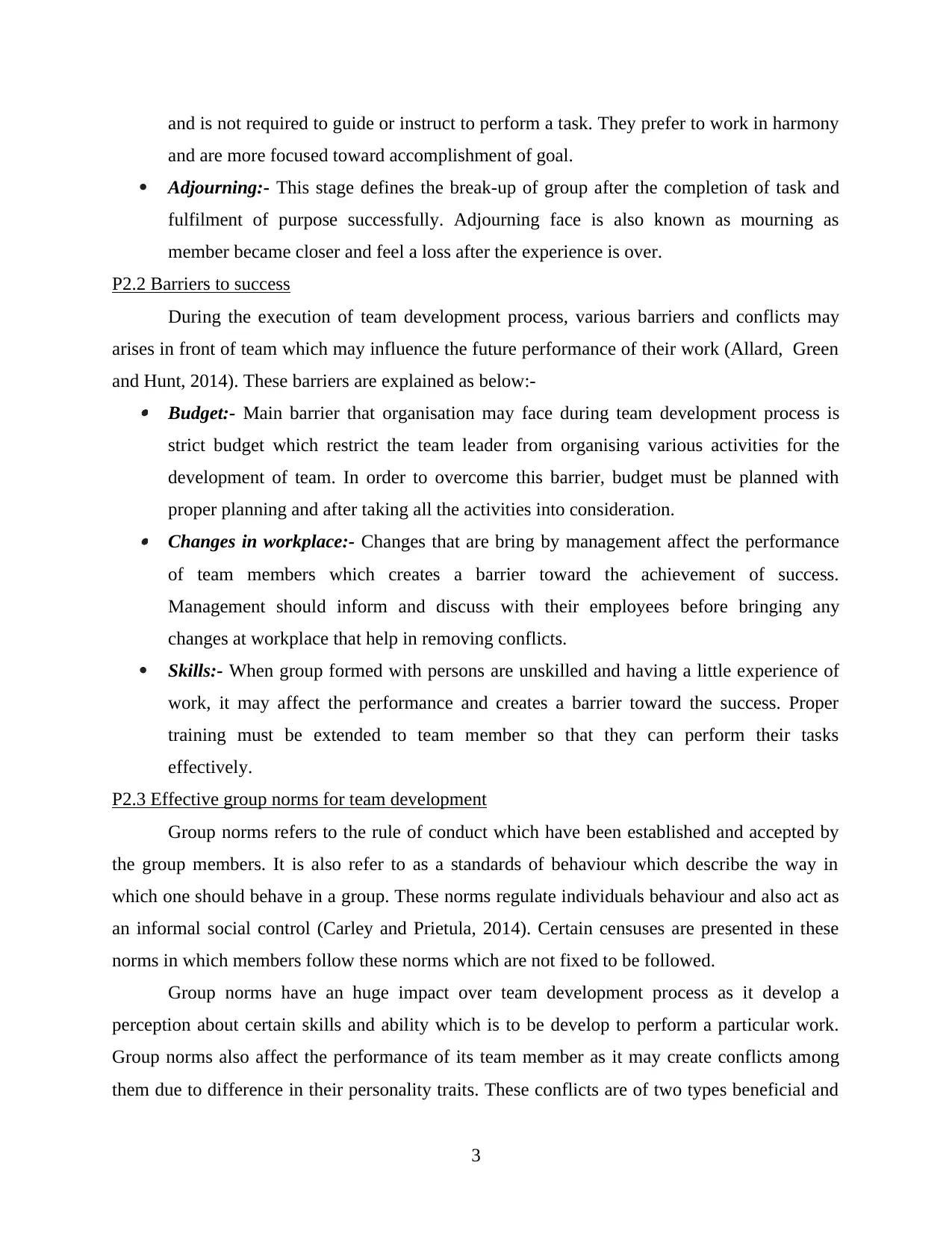
and is not required to guide or instruct to perform a task. They prefer to work in harmony
and are more focused toward accomplishment of goal.
Adjourning:- This stage defines the break-up of group after the completion of task and
fulfilment of purpose successfully. Adjourning face is also known as mourning as
member became closer and feel a loss after the experience is over.
P2.2 Barriers to success
During the execution of team development process, various barriers and conflicts may
arises in front of team which may influence the future performance of their work (Allard, Green
and Hunt, 2014). These barriers are explained as below:- Budget:- Main barrier that organisation may face during team development process is
strict budget which restrict the team leader from organising various activities for the
development of team. In order to overcome this barrier, budget must be planned with
proper planning and after taking all the activities into consideration. Changes in workplace:- Changes that are bring by management affect the performance
of team members which creates a barrier toward the achievement of success.
Management should inform and discuss with their employees before bringing any
changes at workplace that help in removing conflicts.
Skills:- When group formed with persons are unskilled and having a little experience of
work, it may affect the performance and creates a barrier toward the success. Proper
training must be extended to team member so that they can perform their tasks
effectively.
P2.3 Effective group norms for team development
Group norms refers to the rule of conduct which have been established and accepted by
the group members. It is also refer to as a standards of behaviour which describe the way in
which one should behave in a group. These norms regulate individuals behaviour and also act as
an informal social control (Carley and Prietula, 2014). Certain censuses are presented in these
norms in which members follow these norms which are not fixed to be followed.
Group norms have an huge impact over team development process as it develop a
perception about certain skills and ability which is to be develop to perform a particular work.
Group norms also affect the performance of its team member as it may create conflicts among
them due to difference in their personality traits. These conflicts are of two types beneficial and
3
and are more focused toward accomplishment of goal.
Adjourning:- This stage defines the break-up of group after the completion of task and
fulfilment of purpose successfully. Adjourning face is also known as mourning as
member became closer and feel a loss after the experience is over.
P2.2 Barriers to success
During the execution of team development process, various barriers and conflicts may
arises in front of team which may influence the future performance of their work (Allard, Green
and Hunt, 2014). These barriers are explained as below:- Budget:- Main barrier that organisation may face during team development process is
strict budget which restrict the team leader from organising various activities for the
development of team. In order to overcome this barrier, budget must be planned with
proper planning and after taking all the activities into consideration. Changes in workplace:- Changes that are bring by management affect the performance
of team members which creates a barrier toward the achievement of success.
Management should inform and discuss with their employees before bringing any
changes at workplace that help in removing conflicts.
Skills:- When group formed with persons are unskilled and having a little experience of
work, it may affect the performance and creates a barrier toward the success. Proper
training must be extended to team member so that they can perform their tasks
effectively.
P2.3 Effective group norms for team development
Group norms refers to the rule of conduct which have been established and accepted by
the group members. It is also refer to as a standards of behaviour which describe the way in
which one should behave in a group. These norms regulate individuals behaviour and also act as
an informal social control (Carley and Prietula, 2014). Certain censuses are presented in these
norms in which members follow these norms which are not fixed to be followed.
Group norms have an huge impact over team development process as it develop a
perception about certain skills and ability which is to be develop to perform a particular work.
Group norms also affect the performance of its team member as it may create conflicts among
them due to difference in their personality traits. These conflicts are of two types beneficial and
3
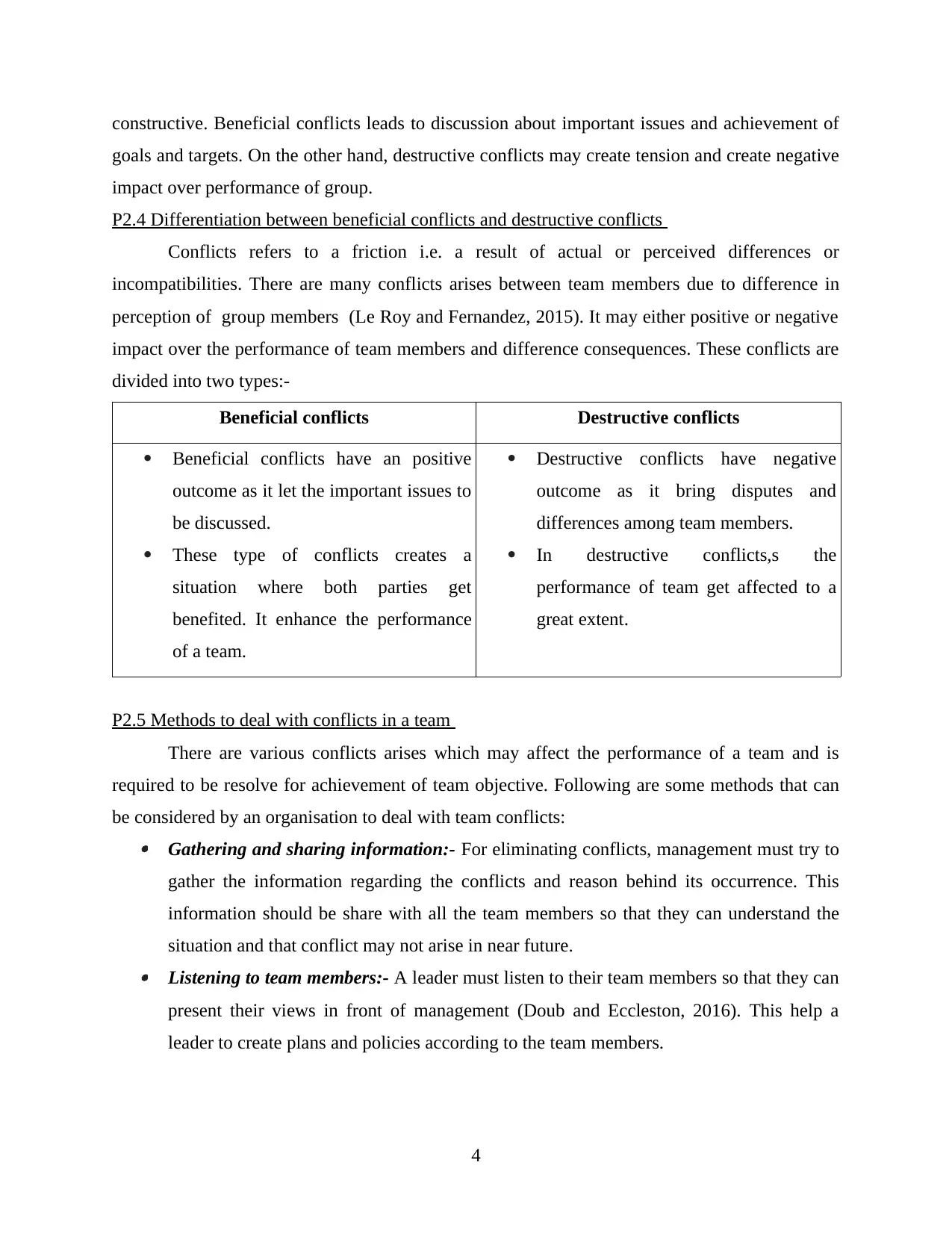
constructive. Beneficial conflicts leads to discussion about important issues and achievement of
goals and targets. On the other hand, destructive conflicts may create tension and create negative
impact over performance of group.
P2.4 Differentiation between beneficial conflicts and destructive conflicts
Conflicts refers to a friction i.e. a result of actual or perceived differences or
incompatibilities. There are many conflicts arises between team members due to difference in
perception of group members (Le Roy and Fernandez, 2015). It may either positive or negative
impact over the performance of team members and difference consequences. These conflicts are
divided into two types:-
Beneficial conflicts Destructive conflicts
Beneficial conflicts have an positive
outcome as it let the important issues to
be discussed.
These type of conflicts creates a
situation where both parties get
benefited. It enhance the performance
of a team.
Destructive conflicts have negative
outcome as it bring disputes and
differences among team members.
In destructive conflicts,s the
performance of team get affected to a
great extent.
P2.5 Methods to deal with conflicts in a team
There are various conflicts arises which may affect the performance of a team and is
required to be resolve for achievement of team objective. Following are some methods that can
be considered by an organisation to deal with team conflicts: Gathering and sharing information:- For eliminating conflicts, management must try to
gather the information regarding the conflicts and reason behind its occurrence. This
information should be share with all the team members so that they can understand the
situation and that conflict may not arise in near future. Listening to team members:- A leader must listen to their team members so that they can
present their views in front of management (Doub and Eccleston, 2016). This help a
leader to create plans and policies according to the team members.
4
goals and targets. On the other hand, destructive conflicts may create tension and create negative
impact over performance of group.
P2.4 Differentiation between beneficial conflicts and destructive conflicts
Conflicts refers to a friction i.e. a result of actual or perceived differences or
incompatibilities. There are many conflicts arises between team members due to difference in
perception of group members (Le Roy and Fernandez, 2015). It may either positive or negative
impact over the performance of team members and difference consequences. These conflicts are
divided into two types:-
Beneficial conflicts Destructive conflicts
Beneficial conflicts have an positive
outcome as it let the important issues to
be discussed.
These type of conflicts creates a
situation where both parties get
benefited. It enhance the performance
of a team.
Destructive conflicts have negative
outcome as it bring disputes and
differences among team members.
In destructive conflicts,s the
performance of team get affected to a
great extent.
P2.5 Methods to deal with conflicts in a team
There are various conflicts arises which may affect the performance of a team and is
required to be resolve for achievement of team objective. Following are some methods that can
be considered by an organisation to deal with team conflicts: Gathering and sharing information:- For eliminating conflicts, management must try to
gather the information regarding the conflicts and reason behind its occurrence. This
information should be share with all the team members so that they can understand the
situation and that conflict may not arise in near future. Listening to team members:- A leader must listen to their team members so that they can
present their views in front of management (Doub and Eccleston, 2016). This help a
leader to create plans and policies according to the team members.
4
⊘ This is a preview!⊘
Do you want full access?
Subscribe today to unlock all pages.

Trusted by 1+ million students worldwide
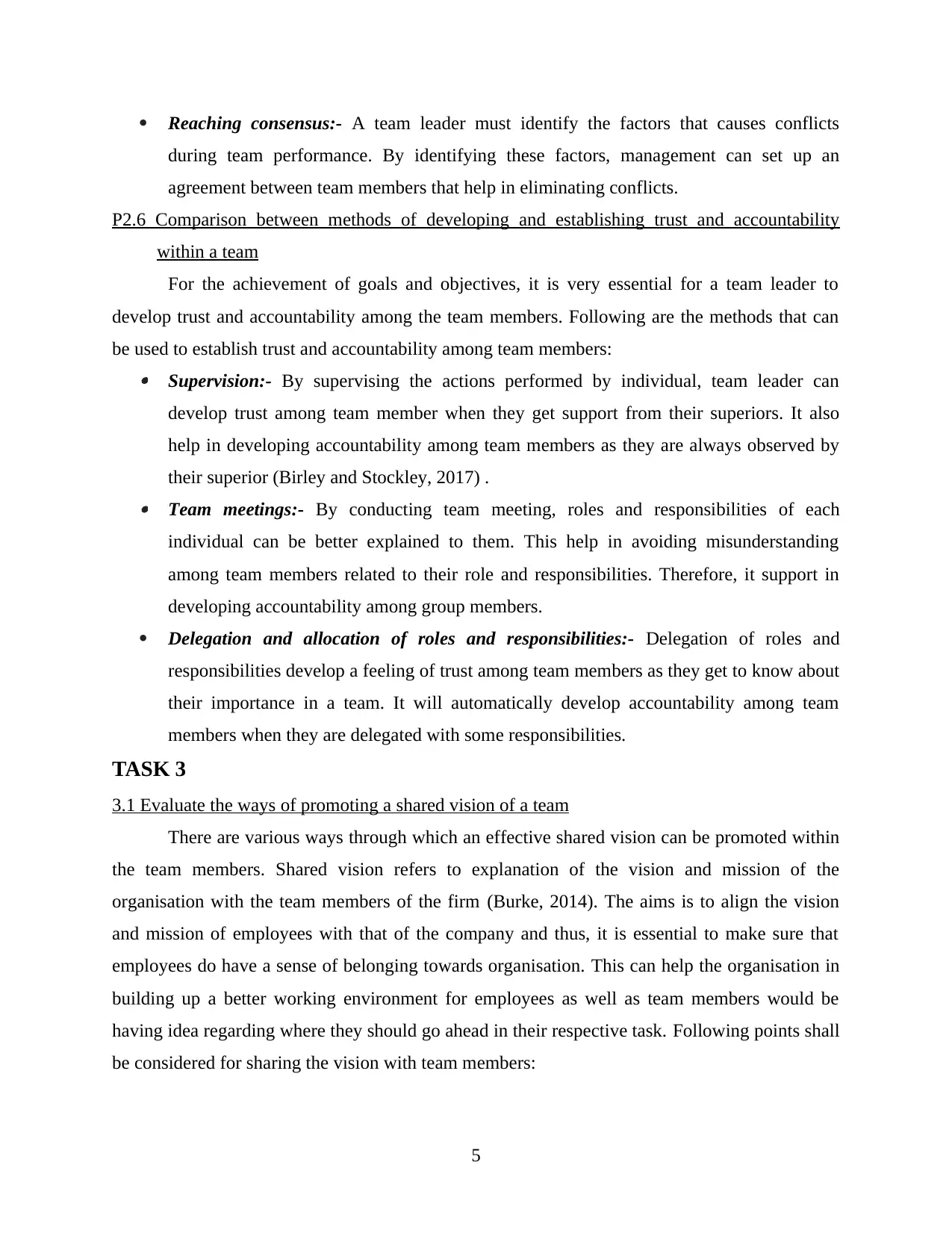
Reaching consensus:- A team leader must identify the factors that causes conflicts
during team performance. By identifying these factors, management can set up an
agreement between team members that help in eliminating conflicts.
P2.6 Comparison between methods of developing and establishing trust and accountability
within a team
For the achievement of goals and objectives, it is very essential for a team leader to
develop trust and accountability among the team members. Following are the methods that can
be used to establish trust and accountability among team members: Supervision:- By supervising the actions performed by individual, team leader can
develop trust among team member when they get support from their superiors. It also
help in developing accountability among team members as they are always observed by
their superior (Birley and Stockley, 2017) . Team meetings:- By conducting team meeting, roles and responsibilities of each
individual can be better explained to them. This help in avoiding misunderstanding
among team members related to their role and responsibilities. Therefore, it support in
developing accountability among group members.
Delegation and allocation of roles and responsibilities:- Delegation of roles and
responsibilities develop a feeling of trust among team members as they get to know about
their importance in a team. It will automatically develop accountability among team
members when they are delegated with some responsibilities.
TASK 3
3.1 Evaluate the ways of promoting a shared vision of a team
There are various ways through which an effective shared vision can be promoted within
the team members. Shared vision refers to explanation of the vision and mission of the
organisation with the team members of the firm (Burke, 2014). The aims is to align the vision
and mission of employees with that of the company and thus, it is essential to make sure that
employees do have a sense of belonging towards organisation. This can help the organisation in
building up a better working environment for employees as well as team members would be
having idea regarding where they should go ahead in their respective task. Following points shall
be considered for sharing the vision with team members:
5
during team performance. By identifying these factors, management can set up an
agreement between team members that help in eliminating conflicts.
P2.6 Comparison between methods of developing and establishing trust and accountability
within a team
For the achievement of goals and objectives, it is very essential for a team leader to
develop trust and accountability among the team members. Following are the methods that can
be used to establish trust and accountability among team members: Supervision:- By supervising the actions performed by individual, team leader can
develop trust among team member when they get support from their superiors. It also
help in developing accountability among team members as they are always observed by
their superior (Birley and Stockley, 2017) . Team meetings:- By conducting team meeting, roles and responsibilities of each
individual can be better explained to them. This help in avoiding misunderstanding
among team members related to their role and responsibilities. Therefore, it support in
developing accountability among group members.
Delegation and allocation of roles and responsibilities:- Delegation of roles and
responsibilities develop a feeling of trust among team members as they get to know about
their importance in a team. It will automatically develop accountability among team
members when they are delegated with some responsibilities.
TASK 3
3.1 Evaluate the ways of promoting a shared vision of a team
There are various ways through which an effective shared vision can be promoted within
the team members. Shared vision refers to explanation of the vision and mission of the
organisation with the team members of the firm (Burke, 2014). The aims is to align the vision
and mission of employees with that of the company and thus, it is essential to make sure that
employees do have a sense of belonging towards organisation. This can help the organisation in
building up a better working environment for employees as well as team members would be
having idea regarding where they should go ahead in their respective task. Following points shall
be considered for sharing the vision with team members:
5
Paraphrase This Document
Need a fresh take? Get an instant paraphrase of this document with our AI Paraphraser
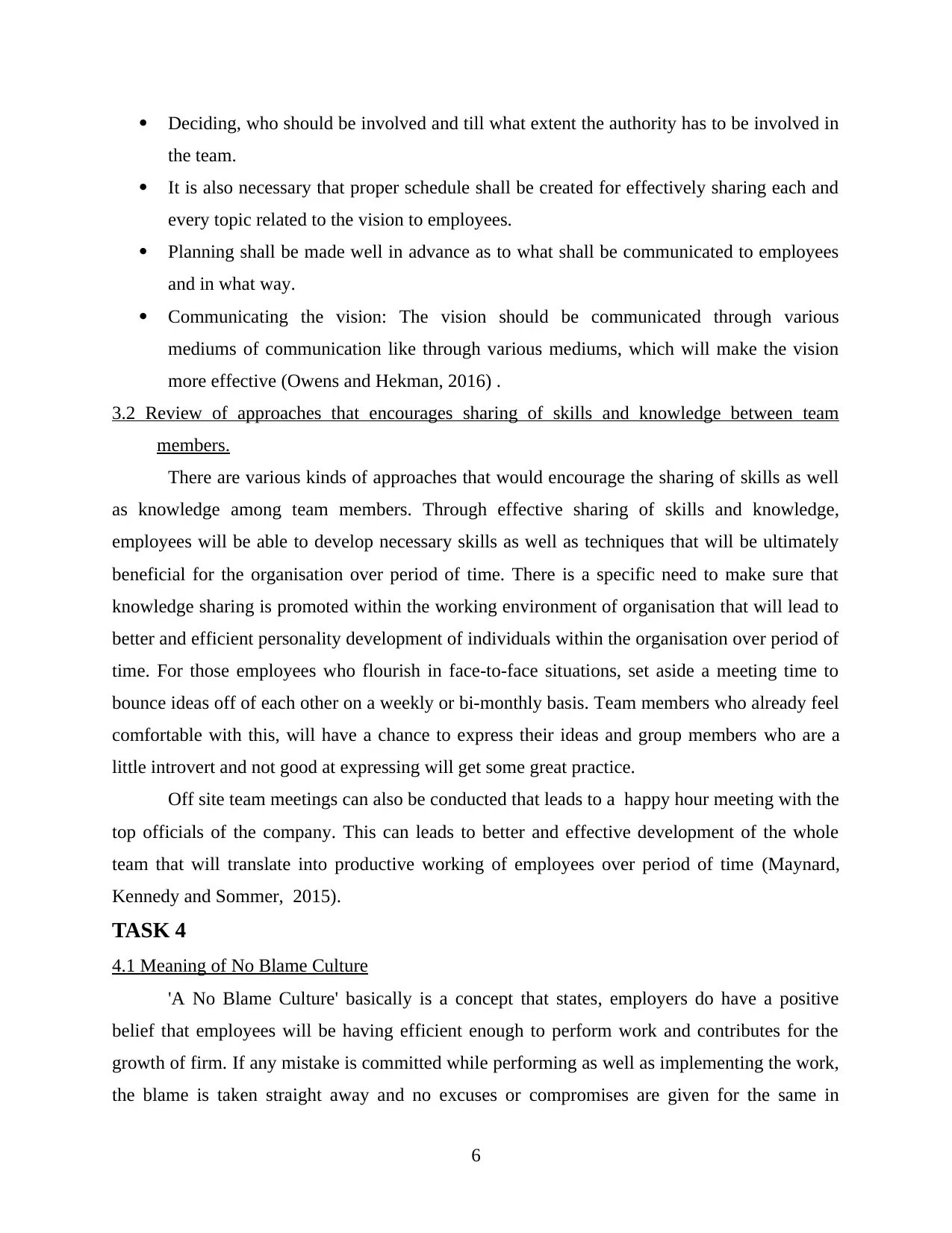
Deciding, who should be involved and till what extent the authority has to be involved in
the team.
It is also necessary that proper schedule shall be created for effectively sharing each and
every topic related to the vision to employees.
Planning shall be made well in advance as to what shall be communicated to employees
and in what way.
Communicating the vision: The vision should be communicated through various
mediums of communication like through various mediums, which will make the vision
more effective (Owens and Hekman, 2016) .
3.2 Review of approaches that encourages sharing of skills and knowledge between team
members.
There are various kinds of approaches that would encourage the sharing of skills as well
as knowledge among team members. Through effective sharing of skills and knowledge,
employees will be able to develop necessary skills as well as techniques that will be ultimately
beneficial for the organisation over period of time. There is a specific need to make sure that
knowledge sharing is promoted within the working environment of organisation that will lead to
better and efficient personality development of individuals within the organisation over period of
time. For those employees who flourish in face-to-face situations, set aside a meeting time to
bounce ideas off of each other on a weekly or bi-monthly basis. Team members who already feel
comfortable with this, will have a chance to express their ideas and group members who are a
little introvert and not good at expressing will get some great practice.
Off site team meetings can also be conducted that leads to a happy hour meeting with the
top officials of the company. This can leads to better and effective development of the whole
team that will translate into productive working of employees over period of time (Maynard,
Kennedy and Sommer, 2015).
TASK 4
4.1 Meaning of No Blame Culture
'A No Blame Culture' basically is a concept that states, employers do have a positive
belief that employees will be having efficient enough to perform work and contributes for the
growth of firm. If any mistake is committed while performing as well as implementing the work,
the blame is taken straight away and no excuses or compromises are given for the same in
6
the team.
It is also necessary that proper schedule shall be created for effectively sharing each and
every topic related to the vision to employees.
Planning shall be made well in advance as to what shall be communicated to employees
and in what way.
Communicating the vision: The vision should be communicated through various
mediums of communication like through various mediums, which will make the vision
more effective (Owens and Hekman, 2016) .
3.2 Review of approaches that encourages sharing of skills and knowledge between team
members.
There are various kinds of approaches that would encourage the sharing of skills as well
as knowledge among team members. Through effective sharing of skills and knowledge,
employees will be able to develop necessary skills as well as techniques that will be ultimately
beneficial for the organisation over period of time. There is a specific need to make sure that
knowledge sharing is promoted within the working environment of organisation that will lead to
better and efficient personality development of individuals within the organisation over period of
time. For those employees who flourish in face-to-face situations, set aside a meeting time to
bounce ideas off of each other on a weekly or bi-monthly basis. Team members who already feel
comfortable with this, will have a chance to express their ideas and group members who are a
little introvert and not good at expressing will get some great practice.
Off site team meetings can also be conducted that leads to a happy hour meeting with the
top officials of the company. This can leads to better and effective development of the whole
team that will translate into productive working of employees over period of time (Maynard,
Kennedy and Sommer, 2015).
TASK 4
4.1 Meaning of No Blame Culture
'A No Blame Culture' basically is a concept that states, employers do have a positive
belief that employees will be having efficient enough to perform work and contributes for the
growth of firm. If any mistake is committed while performing as well as implementing the work,
the blame is taken straight away and no excuses or compromises are given for the same in
6
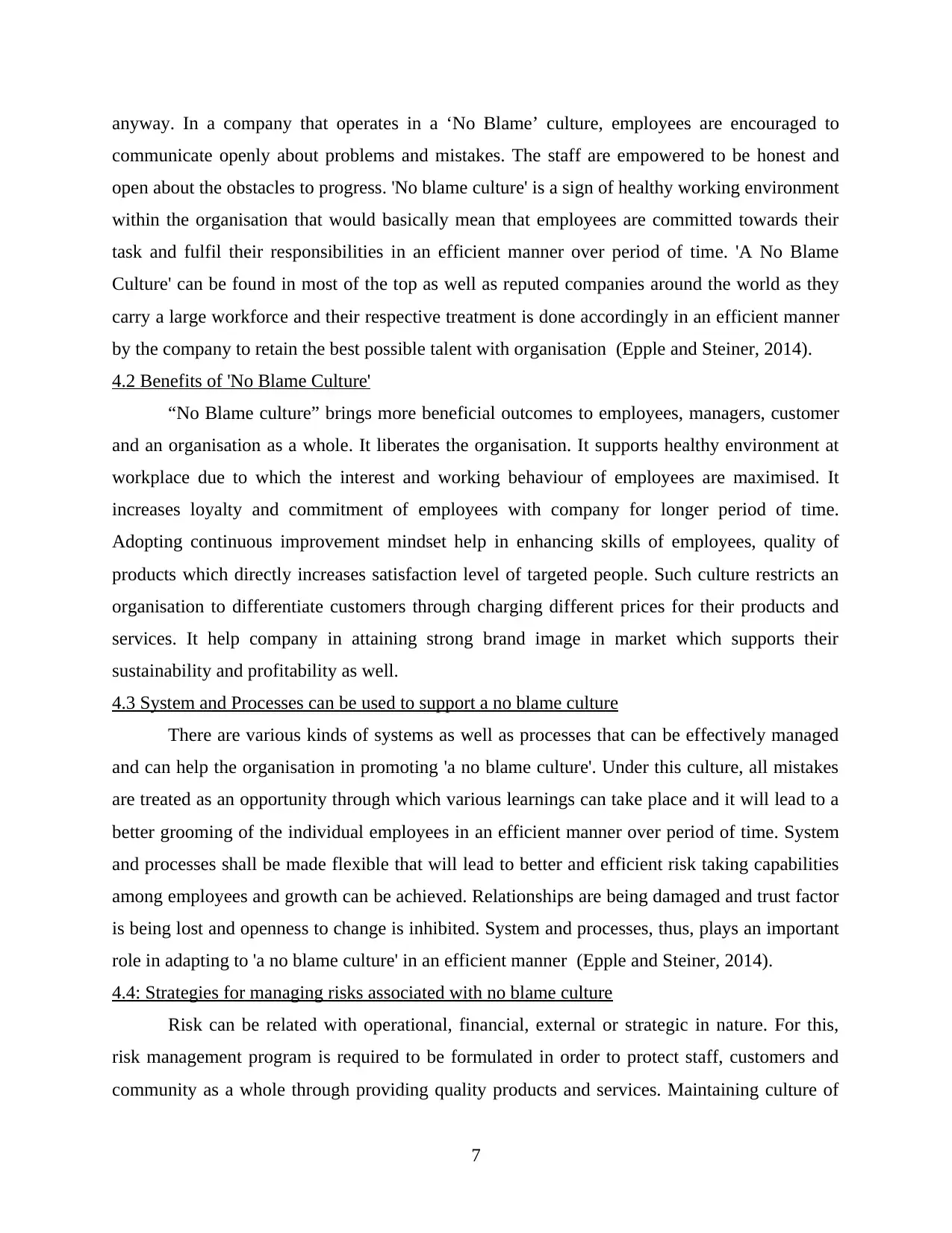
anyway. In a company that operates in a ‘No Blame’ culture, employees are encouraged to
communicate openly about problems and mistakes. The staff are empowered to be honest and
open about the obstacles to progress. 'No blame culture' is a sign of healthy working environment
within the organisation that would basically mean that employees are committed towards their
task and fulfil their responsibilities in an efficient manner over period of time. 'A No Blame
Culture' can be found in most of the top as well as reputed companies around the world as they
carry a large workforce and their respective treatment is done accordingly in an efficient manner
by the company to retain the best possible talent with organisation (Epple and Steiner, 2014).
4.2 Benefits of 'No Blame Culture'
“No Blame culture” brings more beneficial outcomes to employees, managers, customer
and an organisation as a whole. It liberates the organisation. It supports healthy environment at
workplace due to which the interest and working behaviour of employees are maximised. It
increases loyalty and commitment of employees with company for longer period of time.
Adopting continuous improvement mindset help in enhancing skills of employees, quality of
products which directly increases satisfaction level of targeted people. Such culture restricts an
organisation to differentiate customers through charging different prices for their products and
services. It help company in attaining strong brand image in market which supports their
sustainability and profitability as well.
4.3 System and Processes can be used to support a no blame culture
There are various kinds of systems as well as processes that can be effectively managed
and can help the organisation in promoting 'a no blame culture'. Under this culture, all mistakes
are treated as an opportunity through which various learnings can take place and it will lead to a
better grooming of the individual employees in an efficient manner over period of time. System
and processes shall be made flexible that will lead to better and efficient risk taking capabilities
among employees and growth can be achieved. Relationships are being damaged and trust factor
is being lost and openness to change is inhibited. System and processes, thus, plays an important
role in adapting to 'a no blame culture' in an efficient manner (Epple and Steiner, 2014).
4.4: Strategies for managing risks associated with no blame culture
Risk can be related with operational, financial, external or strategic in nature. For this,
risk management program is required to be formulated in order to protect staff, customers and
community as a whole through providing quality products and services. Maintaining culture of
7
communicate openly about problems and mistakes. The staff are empowered to be honest and
open about the obstacles to progress. 'No blame culture' is a sign of healthy working environment
within the organisation that would basically mean that employees are committed towards their
task and fulfil their responsibilities in an efficient manner over period of time. 'A No Blame
Culture' can be found in most of the top as well as reputed companies around the world as they
carry a large workforce and their respective treatment is done accordingly in an efficient manner
by the company to retain the best possible talent with organisation (Epple and Steiner, 2014).
4.2 Benefits of 'No Blame Culture'
“No Blame culture” brings more beneficial outcomes to employees, managers, customer
and an organisation as a whole. It liberates the organisation. It supports healthy environment at
workplace due to which the interest and working behaviour of employees are maximised. It
increases loyalty and commitment of employees with company for longer period of time.
Adopting continuous improvement mindset help in enhancing skills of employees, quality of
products which directly increases satisfaction level of targeted people. Such culture restricts an
organisation to differentiate customers through charging different prices for their products and
services. It help company in attaining strong brand image in market which supports their
sustainability and profitability as well.
4.3 System and Processes can be used to support a no blame culture
There are various kinds of systems as well as processes that can be effectively managed
and can help the organisation in promoting 'a no blame culture'. Under this culture, all mistakes
are treated as an opportunity through which various learnings can take place and it will lead to a
better grooming of the individual employees in an efficient manner over period of time. System
and processes shall be made flexible that will lead to better and efficient risk taking capabilities
among employees and growth can be achieved. Relationships are being damaged and trust factor
is being lost and openness to change is inhibited. System and processes, thus, plays an important
role in adapting to 'a no blame culture' in an efficient manner (Epple and Steiner, 2014).
4.4: Strategies for managing risks associated with no blame culture
Risk can be related with operational, financial, external or strategic in nature. For this,
risk management program is required to be formulated in order to protect staff, customers and
community as a whole through providing quality products and services. Maintaining culture of
7
⊘ This is a preview!⊘
Do you want full access?
Subscribe today to unlock all pages.

Trusted by 1+ million students worldwide
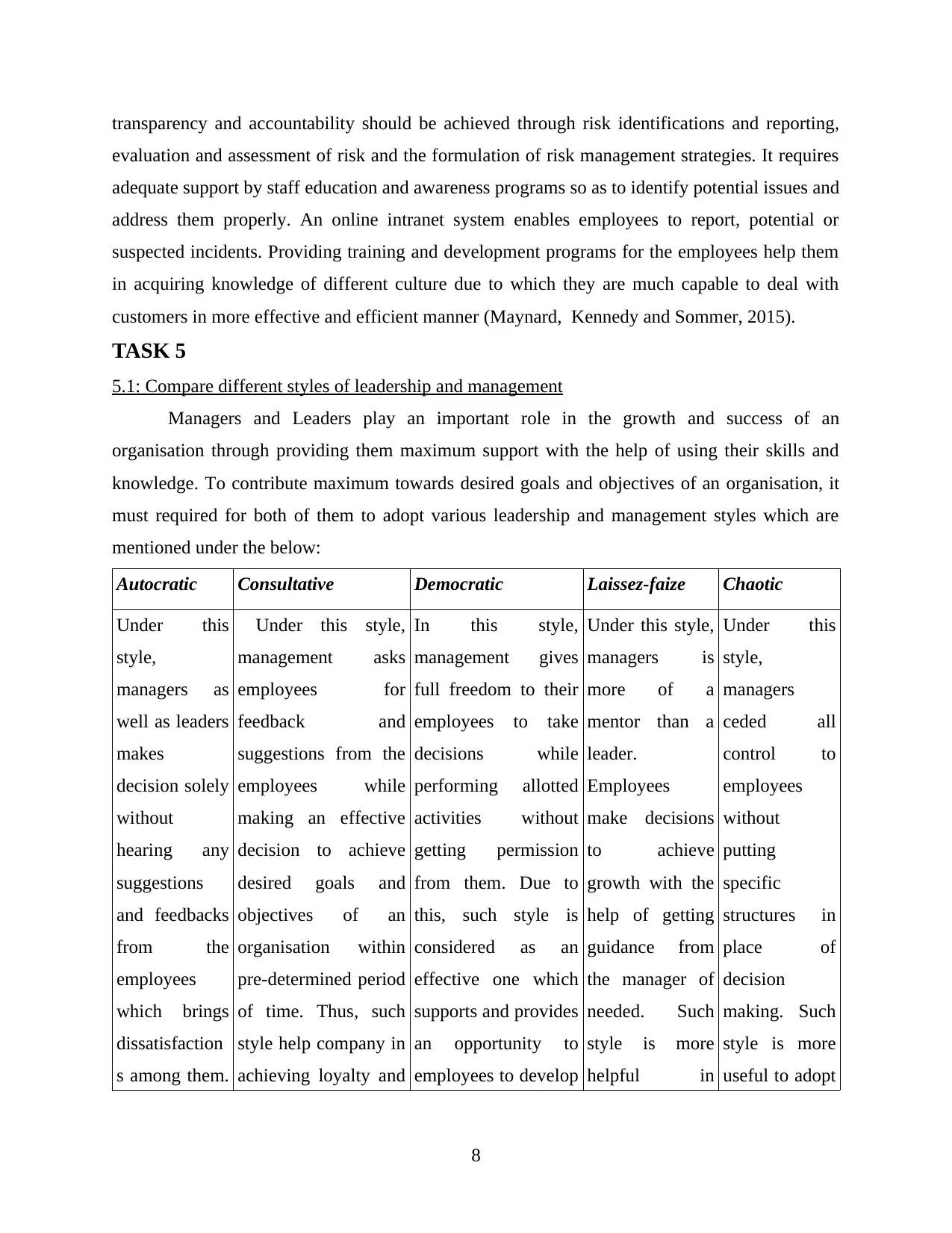
transparency and accountability should be achieved through risk identifications and reporting,
evaluation and assessment of risk and the formulation of risk management strategies. It requires
adequate support by staff education and awareness programs so as to identify potential issues and
address them properly. An online intranet system enables employees to report, potential or
suspected incidents. Providing training and development programs for the employees help them
in acquiring knowledge of different culture due to which they are much capable to deal with
customers in more effective and efficient manner (Maynard, Kennedy and Sommer, 2015).
TASK 5
5.1: Compare different styles of leadership and management
Managers and Leaders play an important role in the growth and success of an
organisation through providing them maximum support with the help of using their skills and
knowledge. To contribute maximum towards desired goals and objectives of an organisation, it
must required for both of them to adopt various leadership and management styles which are
mentioned under the below:
Autocratic Consultative Democratic Laissez-faize Chaotic
Under this
style,
managers as
well as leaders
makes
decision solely
without
hearing any
suggestions
and feedbacks
from the
employees
which brings
dissatisfaction
s among them.
Under this style,
management asks
employees for
feedback and
suggestions from the
employees while
making an effective
decision to achieve
desired goals and
objectives of an
organisation within
pre-determined period
of time. Thus, such
style help company in
achieving loyalty and
In this style,
management gives
full freedom to their
employees to take
decisions while
performing allotted
activities without
getting permission
from them. Due to
this, such style is
considered as an
effective one which
supports and provides
an opportunity to
employees to develop
Under this style,
managers is
more of a
mentor than a
leader.
Employees
make decisions
to achieve
growth with the
help of getting
guidance from
the manager of
needed. Such
style is more
helpful in
Under this
style,
managers
ceded all
control to
employees
without
putting
specific
structures in
place of
decision
making. Such
style is more
useful to adopt
8
evaluation and assessment of risk and the formulation of risk management strategies. It requires
adequate support by staff education and awareness programs so as to identify potential issues and
address them properly. An online intranet system enables employees to report, potential or
suspected incidents. Providing training and development programs for the employees help them
in acquiring knowledge of different culture due to which they are much capable to deal with
customers in more effective and efficient manner (Maynard, Kennedy and Sommer, 2015).
TASK 5
5.1: Compare different styles of leadership and management
Managers and Leaders play an important role in the growth and success of an
organisation through providing them maximum support with the help of using their skills and
knowledge. To contribute maximum towards desired goals and objectives of an organisation, it
must required for both of them to adopt various leadership and management styles which are
mentioned under the below:
Autocratic Consultative Democratic Laissez-faize Chaotic
Under this
style,
managers as
well as leaders
makes
decision solely
without
hearing any
suggestions
and feedbacks
from the
employees
which brings
dissatisfaction
s among them.
Under this style,
management asks
employees for
feedback and
suggestions from the
employees while
making an effective
decision to achieve
desired goals and
objectives of an
organisation within
pre-determined period
of time. Thus, such
style help company in
achieving loyalty and
In this style,
management gives
full freedom to their
employees to take
decisions while
performing allotted
activities without
getting permission
from them. Due to
this, such style is
considered as an
effective one which
supports and provides
an opportunity to
employees to develop
Under this style,
managers is
more of a
mentor than a
leader.
Employees
make decisions
to achieve
growth with the
help of getting
guidance from
the manager of
needed. Such
style is more
helpful in
Under this
style,
managers
ceded all
control to
employees
without
putting
specific
structures in
place of
decision
making. Such
style is more
useful to adopt
8
Paraphrase This Document
Need a fresh take? Get an instant paraphrase of this document with our AI Paraphraser
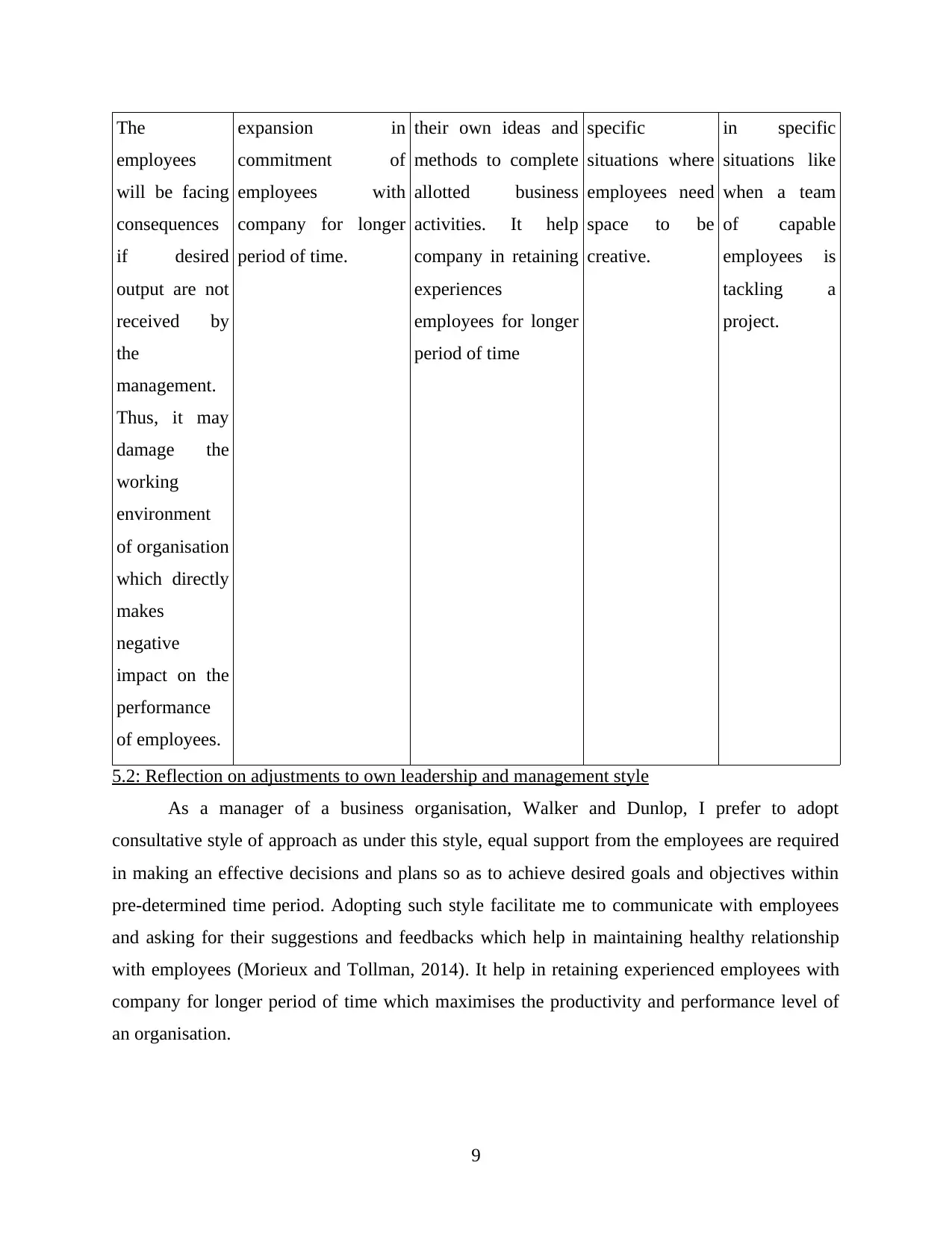
The
employees
will be facing
consequences
if desired
output are not
received by
the
management.
Thus, it may
damage the
working
environment
of organisation
which directly
makes
negative
impact on the
performance
of employees.
expansion in
commitment of
employees with
company for longer
period of time.
their own ideas and
methods to complete
allotted business
activities. It help
company in retaining
experiences
employees for longer
period of time
specific
situations where
employees need
space to be
creative.
in specific
situations like
when a team
of capable
employees is
tackling a
project.
5.2: Reflection on adjustments to own leadership and management style
As a manager of a business organisation, Walker and Dunlop, I prefer to adopt
consultative style of approach as under this style, equal support from the employees are required
in making an effective decisions and plans so as to achieve desired goals and objectives within
pre-determined time period. Adopting such style facilitate me to communicate with employees
and asking for their suggestions and feedbacks which help in maintaining healthy relationship
with employees (Morieux and Tollman, 2014). It help in retaining experienced employees with
company for longer period of time which maximises the productivity and performance level of
an organisation.
9
employees
will be facing
consequences
if desired
output are not
received by
the
management.
Thus, it may
damage the
working
environment
of organisation
which directly
makes
negative
impact on the
performance
of employees.
expansion in
commitment of
employees with
company for longer
period of time.
their own ideas and
methods to complete
allotted business
activities. It help
company in retaining
experiences
employees for longer
period of time
specific
situations where
employees need
space to be
creative.
in specific
situations like
when a team
of capable
employees is
tackling a
project.
5.2: Reflection on adjustments to own leadership and management style
As a manager of a business organisation, Walker and Dunlop, I prefer to adopt
consultative style of approach as under this style, equal support from the employees are required
in making an effective decisions and plans so as to achieve desired goals and objectives within
pre-determined time period. Adopting such style facilitate me to communicate with employees
and asking for their suggestions and feedbacks which help in maintaining healthy relationship
with employees (Morieux and Tollman, 2014). It help in retaining experienced employees with
company for longer period of time which maximises the productivity and performance level of
an organisation.
9

CONCLUSION
From the above given report it has been concluded that team is considered as an essential
element of each business organisation as it plays vast role in developing the operations of the
firm in effective manner. In an organisation, manager plays vast role in building team in respect
to conduct all the business operations in appropriate way through proper coordination of
employees. Team building is effective in accomplishing organisational goals and objectives
through the coordination and collaboration of employees working.
10
From the above given report it has been concluded that team is considered as an essential
element of each business organisation as it plays vast role in developing the operations of the
firm in effective manner. In an organisation, manager plays vast role in building team in respect
to conduct all the business operations in appropriate way through proper coordination of
employees. Team building is effective in accomplishing organisational goals and objectives
through the coordination and collaboration of employees working.
10
⊘ This is a preview!⊘
Do you want full access?
Subscribe today to unlock all pages.

Trusted by 1+ million students worldwide
1 out of 13
Related Documents
Your All-in-One AI-Powered Toolkit for Academic Success.
+13062052269
info@desklib.com
Available 24*7 on WhatsApp / Email
![[object Object]](/_next/static/media/star-bottom.7253800d.svg)
Unlock your academic potential
Copyright © 2020–2025 A2Z Services. All Rights Reserved. Developed and managed by ZUCOL.





